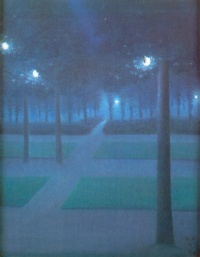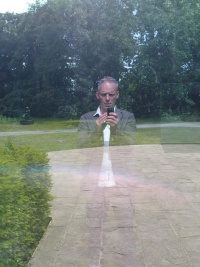Park
From The Art and Popular Culture Encyclopedia
| Revision as of 09:15, 17 April 2021 Jahsonic (Talk | contribs) ← Previous diff |
Current revision Jahsonic (Talk | contribs) (→See also) |
||
| Line 3: | Line 3: | ||
| | style="text-align: left;" | | | style="text-align: left;" | | ||
| "HER LOVER one day takes [[Story of O|O]] for a walk in a section of the city where they never go - the [[Parc Montsouris|Montsouris Park]], the [[Parc Monceau |Monceau Park]]." | "HER LOVER one day takes [[Story of O|O]] for a walk in a section of the city where they never go - the [[Parc Montsouris|Montsouris Park]], the [[Parc Monceau |Monceau Park]]." | ||
| + | <hr> | ||
| + | "With the [[Industrial Revolution]] [[park]]s took on a new meaning as areas set aside to preserve a sense of nature in the cities and towns. Areas of outstanding [[natural]] beauty were also set aside as [[national park]]s to prevent their being spoiled by uncontrolled development."--Sholem Stein | ||
| |} | |} | ||
| [[Image:Sunday Afternoon on the Island of La Grande Jatte (1884-1886) - Seurat.jpg|thumb|right|200px|''[[A Sunday Afternoon on the Island of La Grande Jatte]]'' (1884-1886) - Georges Seurat]] | [[Image:Sunday Afternoon on the Island of La Grande Jatte (1884-1886) - Seurat.jpg|thumb|right|200px|''[[A Sunday Afternoon on the Island of La Grande Jatte]]'' (1884-1886) - Georges Seurat]] | ||
| Line 11: | Line 13: | ||
| A '''park''' is a bounded area of [[land]], usually in its natural or [[artificial|semi-natural]] ([[landscape]]d) state and set aside for some purpose, usually to do with [[recreation]]. | A '''park''' is a bounded area of [[land]], usually in its natural or [[artificial|semi-natural]] ([[landscape]]d) state and set aside for some purpose, usually to do with [[recreation]]. | ||
| + | ==History== | ||
| + | [[Deer park (England)|English deer parks]] were used by the [[aristocracy]] in [[medieval]] times for game hunting. They had walls or thick hedges around them to keep game animals (e.g., stags) in and people out. It was strictly forbidden for commoners to hunt animals in these deer parks. | ||
| + | |||
| + | These game preserves evolved into landscaped parks set around [[mansion]]s and [[country house]]s from the sixteenth century onward. These may have served as hunting grounds but they also proclaimed the owner's wealth and status. An aesthetic of landscape design began in these [[stately home]] parks where the [[natural landscape]] was enhanced by [[landscape architect]]s such as [[Capability Brown]] and [[Humphry Repton]]. The [[French formal garden]] such as designed by [[André Le Nôtre]] at [[Palace of Versailles|Versailles]] are an earlier and elaborate example. As cities became crowded, the private hunting grounds became places for the public. | ||
| + | |||
| + | Early opportunities for the creation of urban parks in both Europe and the United States grew out of medieval practice to secure pasture lands within the safe confines of villages and towns. The most famous US example of a city park evolved from this practice is the Boston Commons in Boston, Massachusetts (1634). | ||
| + | |||
| + | With the [[Industrial revolution]] parks took on a new meaning as areas set aside to preserve a sense of nature in the cities and towns. Sporting activity came to be a major use for these urban parks. Areas of outstanding [[natural]] beauty were also set aside as [[national park]]s to prevent their being spoiled by uncontrolled development. | ||
| == Some parks == | == Some parks == | ||
| Line 22: | Line 32: | ||
| *''[[Punishment Park]]'' | *''[[Punishment Park]]'' | ||
| *''[[The Panic in Needle Park]]'' | *''[[The Panic in Needle Park]]'' | ||
| + | ==Etymology== | ||
| + | From Middle English park, from Old French parc (“livestock pen”), from Medieval Latin parcus, parricus, from Frankish *parrik (“enclosure, pen”), from Proto-Germanic *parrukaz (“enclosure, fence”). Cognate with Dutch perk (“enclosure; flowerbed”), Old High German pfarrih, pferrih (“enclosure, pen”), Old English pearroc (“enclosure”) (whence modern English paddock), Old Norse parrak, parak (“enclosure, pen; distress, anxiety”), Icelandic parraka (“to keep pent in, under restraint and coercion”). More at parrock, paddock. | ||
| + | |||
| == See also == | == See also == | ||
| - | *[[Amusement park]] | + | * [[10-Minute Walk]] |
| - | *[[Fête champêtre]] | + | * [[Amusement park]] |
| - | *[[Pleasure garden]] | + | * [[Fête champêtre]] |
| - | == See also == | + | * [[Pleasure garden]] |
| - | *[[Conservation area]] | + | * [[Landscape architecture]] |
| - | *[[Landscape architecture]] | + | * [[Public open space]] |
| - | *[[Protected area]] | + | * [[Royal forest]] |
| - | *[[Public open space]] | + | * [[Urban open space]] |
| - | *[[Royal forest]] | + | |
| - | *[[Urban open space]] | + | |
| {{GFDL}} | {{GFDL}} | ||
Current revision

|
"HER LOVER one day takes O for a walk in a section of the city where they never go - the Montsouris Park, the Monceau Park." "With the Industrial Revolution parks took on a new meaning as areas set aside to preserve a sense of nature in the cities and towns. Areas of outstanding natural beauty were also set aside as national parks to prevent their being spoiled by uncontrolled development."--Sholem Stein |
_-_Seurat.jpg)
|
Related e |
|
Featured: |
A park is a bounded area of land, usually in its natural or semi-natural (landscaped) state and set aside for some purpose, usually to do with recreation.
Contents |
History
English deer parks were used by the aristocracy in medieval times for game hunting. They had walls or thick hedges around them to keep game animals (e.g., stags) in and people out. It was strictly forbidden for commoners to hunt animals in these deer parks.
These game preserves evolved into landscaped parks set around mansions and country houses from the sixteenth century onward. These may have served as hunting grounds but they also proclaimed the owner's wealth and status. An aesthetic of landscape design began in these stately home parks where the natural landscape was enhanced by landscape architects such as Capability Brown and Humphry Repton. The French formal garden such as designed by André Le Nôtre at Versailles are an earlier and elaborate example. As cities became crowded, the private hunting grounds became places for the public.
Early opportunities for the creation of urban parks in both Europe and the United States grew out of medieval practice to secure pasture lands within the safe confines of villages and towns. The most famous US example of a city park evolved from this practice is the Boston Commons in Boston, Massachusetts (1634).
With the Industrial revolution parks took on a new meaning as areas set aside to preserve a sense of nature in the cities and towns. Sporting activity came to be a major use for these urban parks. Areas of outstanding natural beauty were also set aside as national parks to prevent their being spoiled by uncontrolled development.
Some parks
Namesakes
Etymology
From Middle English park, from Old French parc (“livestock pen”), from Medieval Latin parcus, parricus, from Frankish *parrik (“enclosure, pen”), from Proto-Germanic *parrukaz (“enclosure, fence”). Cognate with Dutch perk (“enclosure; flowerbed”), Old High German pfarrih, pferrih (“enclosure, pen”), Old English pearroc (“enclosure”) (whence modern English paddock), Old Norse parrak, parak (“enclosure, pen; distress, anxiety”), Icelandic parraka (“to keep pent in, under restraint and coercion”). More at parrock, paddock.
See also
- 10-Minute Walk
- Amusement park
- Fête champêtre
- Pleasure garden
- Landscape architecture
- Public open space
- Royal forest
- Urban open space


